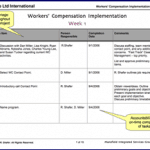Workers’ Compensation for State & Local Government Local and state governments self-insure their risk. A state government has several hundred agencies. State governments will have a state owned self-insurance programand will either: Administer their own workers’ compensation claims, or Farm out the claims administration to a third party administrator (TPA) Municipalities, counties, parishes, and other …
Best Practices
Telecommunications
Medium and small size employers in television, radio, telephone and internet companies can usually obtain workers’ compensation coverage from insurance carriers without difficulty. Most of the national and international companies either: Self-administer their workers’ compensation program, or Have a captive insurance company with a contractual Third Party Administrator (TPA) to handle their claims. The cost …
Temporary Staffing Agencies
Workers’ Compensation for the Temporary Staffing Industry Temporary staffing agencies purchase their workers’ compensation coverage from insurance carriers who specialize in this market. In most states the employees of the temporary staffing agency are considered employees of the agency, not of the agency’s client. The cost of coverage fluctuates based on the nature of the …
Transportation / Fleet Companies
Workers’ Compensation for Transportation / Fleet Industries The cost of workers’ compensation insurance coverage is very close to the median for work comp in general for bus companies, shuttle bus services and taxicab fleets. There are work comp insurers who specialize in this market, but the coverage is also available from most work comp carriers. …
Medical Cost Containment Strategies
Look at the Total Loss Costs (TLC), Not Just the Line-by-Line Items. The best technique to control medical costs in workers’ compensation is a Total Loss Cost (TLC) approach. To be truly effective in controlling the medical cost of workers’ compensation, employers and insurers should not limit their medical cost containment efforts to only one …
Management Roles and Responsibilities In A Workers Compensation Program
Employers who take control and direct the management of their workers compensation injury claims are most likely to see the best results in cost savings. The personnel involved often include the workers compensation claim coordinator, the floor or field supervisors, mid-management, medical personnel, legal, senior management and even the employees. Management Roles and Responsibilities The …
Phase 1: Assessment & Recommendation
Workers’ Comp Improvement Plan – Phase One Team Selection and Information Gathering Phase One – Steps 1 through 9 The steps in the Assessment & Recommendation Phase involve selecting a team and gathering information about your current program, including vendor partners, associated claims, and reported losses. STEP 1: ASSEMBLE PROJECT TEAM The Injury Management Planning …
Reduce Wasteful Workers’ Comp Practices
Strive for Overall Cost Reduction With skyrocketing medical costs, employers must coordinate medical care more effectively. The best way to reduce medical costs is to return employees to their pre-injury health as quickly as possible, and that may mean spending more upfront to provide the best treatment possible. Although you must be familiar with all …
Improve Immediate Injury Response
Have procedures in place from the moment an injury occurs until an employee returns to work on full duty or transitional duty. Having procedures in place sends the message that you – the employer – are in control. Report the claim to your claim administrator immediately so the claims administrator can begin coordinating medical care …
The 7 Biggest Workers’ Comp Mistakes Companies Make!
Workers’ compensation is not just a cost of doing business as many CEOs, CFO’s and Business Owners think. It is an expense within your control. There are two reasons workers compensation costs are high. First, there are too many claims lasting too long. Second, the employer is not taking charge of the workers compensation process. Don’t …







